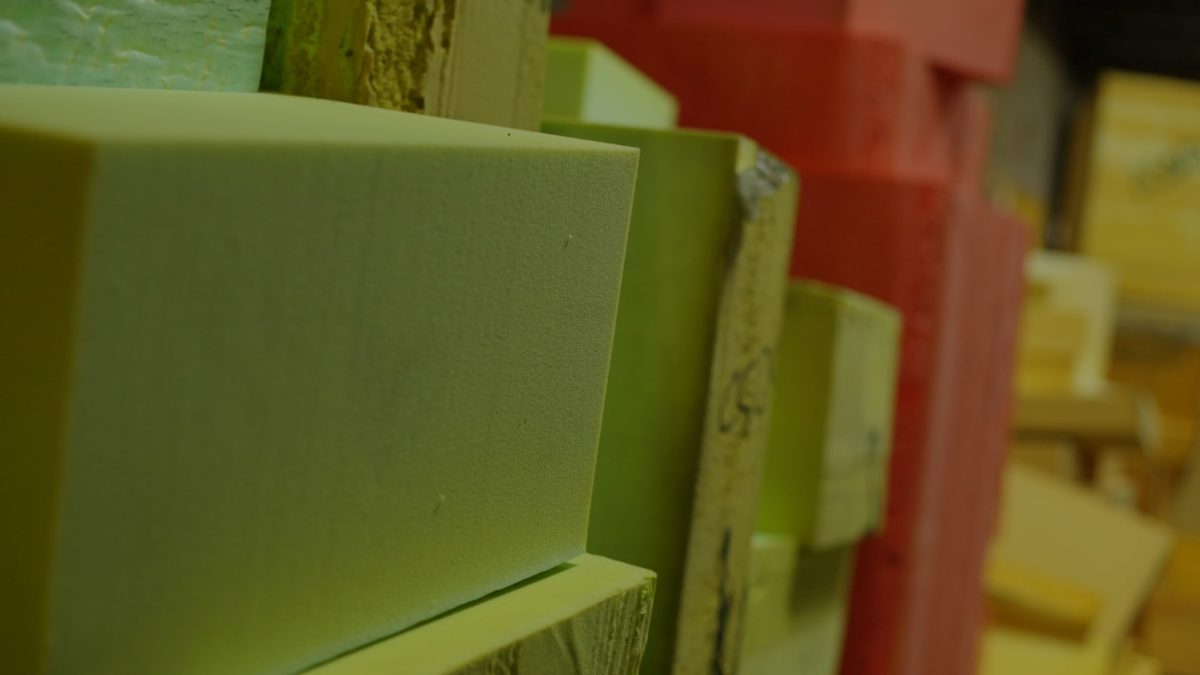Foam lamination is one of the many fabrication techniques used to customize foam materials to make them more useful in certain applications. There is more than one way to laminate a piece of foam, and each process makes the foam more suited to handle specific environmental conditions and applications. What are the main types of foam lamination? Most foam fabricators will specialize in one or all these types of foam laminating methods: Flame Lamination (due to the size and complexity of the flame laminating process, most fabricators do not have this capability and thus this service is provided by a service provider or the actual foam manufacturer), Hot Air Lamination, Hot Plate Lamination, and Adhesive Lamination (which includes PSA Lamination, Hot Glue Lamination, Water-based Adhesive Lamination, and Chemical Bond Adhesive Lamination).
What is Flame Lamination?
Flame lamination refers to the process of heating a piece of foam using an open flame. This allows foam fabricators to join two types of materials together, which creates a unique material that can be used in a variety of applications. During the flame lamination process, manufacturers use open flames to slightly melt the surface of the piece of foam. This creates a tacky and adhesive surface that can be stuck onto another material. When the foam dries and hardens, a bond is formed between the two materials.
Flame lamination can be used to create hybrid pieces of foam or to attach a variety of other materials to a piece of foam. This creates different facings like aluminized mylar, flocking, and Tuftane.
Flame lamination is often used in the following applications:
- Automotive seating and cushioning
- Medical fabrics and cushioning
- Waterproofing and marine foam
- Medical orthotics, braces, mattresses, etc.
- Thermal insulation foam
- Acoustic insulation foam
- Military foam applications
- Sports equipment
Hot Air Lamination
This process is very common in the foam fabrication space—the surface of two pieces of foam is simultaneously heated utilizing a hot air source which leads to some melting of the exposed layer of each piece of material. The parts are then pressed together and fused typically by compression rollers when plank laminating or manually by hand in the case of part lamination.
There are basically two primary methods of hot air lamination:
1) Plank lamination: this is where foams are laminated together in plank form prior to being subjected to the foam fabrication process
2) Part lamination: this is where detailed specific parts are laminated together as indicated in project paperwork or a blueprint specification—typically completed with some a hot air wand of some sort.
Hot plate lamination
This process is growing in popularity in the foam fabrication space. This is especially true with the advent of smart hot plate equipment now available in the market which brings a degree of automation to the process thereby reducing labor costs. The process is simple as one of the pieces of foam is tamped down onto a hot plate in order to cause light melting of the top layer of the foam and then this part is pressed against the target piece of foam some pressure until the bond is completed. Like hot air, this process is very clean as no additional adhesives are required to complete the bond, it is completed with fused plastic and pressure to complete the bond.
What is Adhesive Lamination?
Adhesive lamination is the process of laminating foams by using binding agents such as pressure sensitive adhesives (PSAs), water-based adhesives, hot melt adhesives, or chemical bond adhesives are used to complete the bond of the two components. The adhesives can be applied as liquids that are either sprayed on or brushed onto each surface or through adhesive transfer tapes. Hot melt is typically applied utilizing either a hot glue roller or a hot glue gun. Water-based adhesives are very effective for laminating open cell polyurethanes together. This process is low VOC and very effective for all sorts of polyurethane foam configurations. Hot melt glue is particularly effective for bonding closed cell foams together, however, it can also be used on open cells foams as needed. Hot glue is applied to one surface and then the two surfaces are pressed together to create the bond.
Chemical adhesives are typically used in high end applications where the bond strength and durability are highly critical. The process involves spraying chemical-based adhesive to both surfaces to be bonded and then that adhesive is allowed to tack before the two foam components are bonded together using time and pressure. Once fully cured, this is an extremely strong bond. These adhesion processes achieve a similar effect as heat-based lamination, but they ultimately may add weight to the foam as well as chemicals that have the potential to off-gas. Depending on the application and the environment where it will be used, it may be more effective to use one of the heat-based laminations where possible.
Need laminated foam for your application? Get in touch with the foam fabrication experts at Amcon today!


